What are the forces that sustain tornadoes and dust devils?
replied to: newt90
Replied to: What are the forces that sustain tornadoes and dust devils?...
Dust devils are simpler than tornadoes. Warm air at the ground surface rises, and if the air mass starts to rotate then a "chimney" of rising air becomes contained within a turning wall. The system becomes taller and spins faster as it narrows. More warm air flows into the base of the dust devil, and cooler air from above flows down the outside. The dust devil falls apart rapidly when cooler air enters the base of the column.
A tornado in its initial stages forms as a condensation-driven downdraft from a slowly rotating mother cloud, or mesocyclone. As the end of the funnel reaches the ground it begins to draw warmer air upward, much like the dust devil. The wall of the tornado is formed by the condensation zone of the downdraft, and like the dust devil as it elongates and narrows it spins faster. Once the cooler wall of the tornado cuts off the inflow of warmer air at the base of the windstorm the tornado loses power and dissipates.
replied to: DStahl
Replied to: Dust devils are simpler than tornadoes. Warm air at the ground...
If we stop thinking purely mechanically then the vortex is the natural form taken by Birkeland currents. In other words ionised gas (plasma) naturally creates twisting filamentary paths when electrical imbalance occurs.
We already know that electric currents passing through (metal) conductors cause magnetic fields to form in circular pattern around them. Two currents close together will tend to attract and twist around each other. Plasma being a much better conductor easily zips into these rope shapes. You will start to see Birkeland 'ropes' everywhere you look, especially in space - on a massive scale; not forgetting the novelty plasma ball.
The final connection for tornadoes/ typhoons/ hurricanes, etc is that an electrical system exists around our globe. Quite simply the atmosphere acts like a giant capacitor, storing electric charge - delivered from space. The sun is one source (solar 'wind' = electric path) and outside the solar system we have a giant current source = galaxy. This all combines to form the basis of our weather systems - a continuous source for all the endless thunderstorms happening around the world.
Tornadoes are just a by-product of this electrical system. Read "Observed, also, are correlations with patterns of lightning activity, but these are not yet well understood." in the above Topic Home .."In many cases, very intense tornadoes and thunderstorms exhibit an increased and anomalous dominance of positive polarity CG discharges." It just needs a brain jump to realise that 'temperature' is a measure of atomic activity - who/ what is delivering the energy?
See a few examples here:
http://www.thunderbolts.info/tpod/2005/arch05/050330tornado-electric-discharge.htm
http://www.thunderbolts.info/tpod/2008/arch08/080114electrifieddustdevils.htm
http://www.thunderbolts.info/tpod/2004/arch/040927earth-capacitor.htm
http://www.thunderbolts.info/tpod/2005/arch05/050302electric-earth.htm
http://www.thunderbolts.info/tpod/2006/arch06/060719spacevortex.htm
http://www.thunderbolts.info/tpod/2004/arch/041015solar-tornado.htm
replied to: Cigarshape
Replied to: If we stop thinking purely mechanically then the vortex is the...
I really don't think thats true?
replied to: Cigarshape
Replied to: If we stop thinking purely mechanically then the vortex is the...
Seems like tornadoes-like thunderstorms stir up electricity more ehan vice versa. It also appears that cyclonic air circulation is also driven by an inherent feedback loop involving the low pressure area & the air orbiting around it. I like to compare it to an orbit because the effects of the low pressure area are very similar to gravity. It's not like the low pressure area is a sun & the circling air planets, but more like the vortex is a galaxie & its eye is the core of that same galaxie. My point is that a vortex-as spinning things go-has more in common w/ orbital patterns than a turn table. It spins fastest at its center, & the outer portions take their time coming around. Inward movement towards the low hastens rotation perpetuating the low that keeps it rotating, keeping the rotating air from filling in ect.

